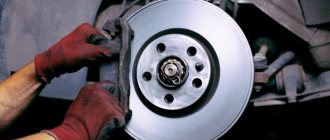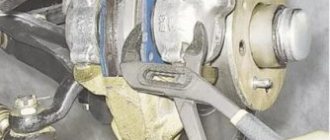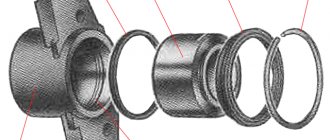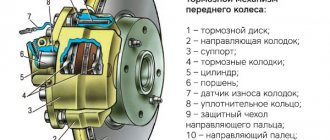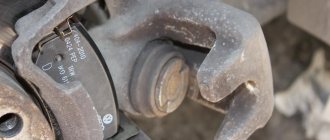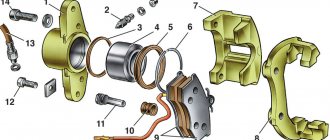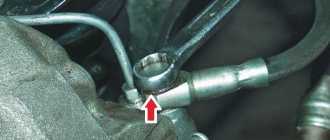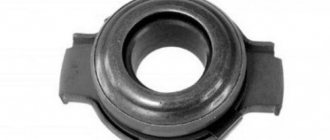Hi all! Any problems associated with the braking system of vehicles are potentially very dangerous. Therefore, every motorist should know why the brake caliper jams, what can provoke such a situation, how to diagnose and eliminate it. On your own or with the help of specialists, decide for yourself.
Our regular readers remember that we have previously talked about situations when the caliper knocks. Now let's consider a slightly different situation. Moreover, it is even more dangerous and unpredictable in terms of possible consequences if nothing is done after noticing the symptoms.
Let's start with the theory. The caliper on a car is part of the brake system. It is used in the design to press automobile brake pads when the corresponding pedal is pressed against the brake disc. As you understand, the node is extremely important.
But sometimes it can jam and creak because of this.
Why the brake caliper jams: how to identify and fix the problem
Read also: Metal balls in varnishes
Hi all! Any problems associated with the braking system of vehicles are potentially very dangerous. Therefore, every motorist should know why the brake caliper jams, what can provoke such a situation, how to diagnose and eliminate it. On your own or with the help of specialists, decide for yourself.
Our regular readers remember that we have previously talked about situations when the caliper knocks. Now let's consider a slightly different situation. Moreover, it is even more dangerous and unpredictable in terms of possible consequences if nothing is done after noticing the symptoms.
Preventive actions
To avoid such an unforeseen situation when the caliper jams on the road, you need to take a number of preventive measures:
With timely care and careful operation of the car, the risk of the caliper getting stuck on the road is minimal. If such a nuisance happens on the road, you need to react quickly and clearly. Remember, if the caliper is jammed, this is fraught with an accident if you cannot cope with the vehicle.
Has your caliper jammed on the road? How did you deal with such a situation? Share your experience with other car enthusiasts.
What to do if the caliper sticks? Answer in video:
To give the calipers an aesthetic appearance, they can be painted. How to do this correctly - read the feature article.
Source
Front caliper jammed
If the front brake caliper is stuck, this is often due to an aggressive driving style. This can be explained by the design difference of modern cars, where the brakes are applied faster at the front. Therefore, the burden here is incredible. Many cars are equipped with a pressure regulator or “sorcerer”. During heavy braking, it blocks fluid access, but only to the rear axle. The front axle continues to work and heat up.
However, if the rear caliper is equipped with a handbrake system, which is provided on some modifications, the likelihood of breakdowns and the rate of wear also increases.
If the brakes rattle
This type of brake has pressure springs or floating calipers.
They are responsible for securing the pads to the caliper body. The reason for their failure is metal fatigue or poor quality. As a result, they lose their elasticity and stop pressing the pads against the body. Because of this, the pads rattle at the slightest passage of irregularities and may come into uneven contact with the disc, which will lead to the appearance of a shoulder or grooves on it. Also in this case, the staples themselves may rattle.
Why does the brake caliper squeak and jam?
A signal that there are problems with a car caliper is a squeaking sound. It may indicate that the caliper is worn out and needs to be replaced, or that a part needs diagnostic maintenance. The squeaking sound when calipers operate most often occurs for one of the following reasons:
Read also: What to do if a parrot laid an egg
The situation is critical when the brake caliper not only creaks, but jams during operation. In other words, the driver presses the brake pedal, and when it is released, the caliper does not remove the pads from the brake discs, which leads to uncontrolled braking of the car, excessive wear and overheating of parts in the brake mechanism.
A little history
The first to create such a model of brakes (disc type) was Frederick Lanchester (Great Britain). It was in its design that a caliper was used that pressed the pads. However, technology at that time did not allow the creation of reliable disc brake systems.
Disc brakes were revived in aviation, and in the 50s they began to be installed on cars - first on sports models, and then on production ones. The first car with serial front disc brakes was the Chrysler Crown Imperial (in 1949).
The importance of this component is difficult to overestimate, because the brake disc and pads are passive components, while the caliper plays an active role. Due to this, the pads are pressed. Therefore, the brake caliper is the most important component.
Consequences
When the bracket wedges, the block remains pressed. This causes the discs to become very hot and the shoes to burn. If the speed of movement is high, and the degree of constriction is maximum, then it’s red-hot. It is obvious that braking efficiency drops sharply, the linings and disc become washed out and lose their properties.
After several heating and cooling procedures, the disks are sure to become deformed. After pressing the pedal, you will feel a beating, and you will not be able to brake at all. You will have to replace the repair kit, but the troubles will not end there, because the cause of the malfunction is in the caliper. If the hub begins to heat up, then the bearing will crumble and the CV joint will be destroyed.
Symptoms of a problem
There are several common signs of a failing brake caliper:
- increased force - this is what needs to be applied to completely stop the machine;
- the car pulls to the side during braking;
- the pedal becomes “soft” - pressing it requires a fairly weak force;
- brake pedal pulsation;
- slight resistance in moving the pedal to the floor;
- brake sticking;
- blocking the rear brakes with great force, etc.
How to carry out independent repairs if the caliper is stuck on the road
If the driver notices signs indicating that the brake mechanism is jammed, the following is urgently required:
- Stop the car. Turn off the engine.
- Take a small board, attach it to the caliper, and knock lightly.
Of course, there is no 100% guarantee of the effectiveness of this method, but when there is absolutely no time, like other available means, they resort to it.
It is best to carry out self-diagnosis. The algorithm is as follows:
- leave the car cold for at least 15 minutes;
- drive 100 meters to warm up the vehicle;
- stop the car, test each wheel - which one will be the hottest, that’s where the caliper is stuck.
Next, carry out the following actions:
- jack up the vehicle and remove the wheel;
- when the handbrake cable is jammed, clean it with universal lubricant WD-40;
- If the piston is jammed, use the plank method described above.
When the driver does not have the skills to carry out emergency repairs, it is better to call a tow truck to take the car to professional mechanics.
What to do in such a situation
If you were able to diagnose creaking and signs of wedging in this unit, you need to perform a number of measures.
And here it is not necessary to contact a car service. You need:
- put the car on a jack;
- remove the wheel;
- unscrew the caliper;
- remove it;
- unscrew the problematic piston;
- remove the piston from the cylinder;
- visually inspect the element;
- check for chips, damage, corrosion;
- if there is rust, clean it;
- if severely damaged, replace;
- drain the working fluid from the element;
- remove the sealing ring;
- clean all surfaces;
- dry;
- fill in new hydraulics;
- assemble in reverse order.
When putting the assembly back together, pay special attention to not accidentally damage the old boot. If you notice cracks on it, then no restoration will help. Replacement only.
How does the GTZ function?
The unit consists of the following parts:
- metal housing with holes for supplying brake fluid, pedal rod and connecting the expansion tank;
- 2 pistons with rubber seals;
- 2 return springs;
- guide bushings;
- end plug with gasket.
An expansion tank is attached to the top of the main distributor body, where excess fluid goes through compensation holes. Inside, the element is divided into 2 cylinders with separate pistons standing on the same axis.
The blind end of the housing is closed with a threaded plug; on the other side there is a flange for attaching to the vacuum booster. The brake pedal rod is attached to the first piston. The brake circuit pipes are connected to the lower holes - separately for the front and rear wheels.
The operating principle of the master brake cylinder looks like this:
- When you press the pedal, both pistons simultaneously move forward and push fluid into the circuit tubes. Under its pressure, the wheel cylinders are activated, compressing the pads on the discs.
- Part of the liquid that does not have time to pass into the tubes flows into the expansion tank through special bypass holes.
- When the driver releases the pedal, the springs push the pistons back, returning them to their original position. Liquid from the tubes and reservoir refills the cylinders.
- To compensate for the expansion of the liquid (for example, from heating), another pair of holes is provided leading to the expansion tank.
Note. The GTZ acts in conjunction with a vacuum booster (not shown in the diagram), which helps put pressure on the pistons. This allows the system to respond faster and make the driver's actions easier.
The piston (cylinder) is faulty
Poor quality of brake fluid, the appearance of rust on the surface when the boot of at least one piston (cylinder) ruptures or as a result of prolonged downtime of the machine entails its partial jamming.
This will initially be heard when its operation is delayed, when the pads begin to knock on the disc. In order to make the repair yourself in this case, you need to disassemble the caliper and pull out the rusty piston; this must be done after the guides have been unscrewed and the boot and retaining ring have been removed.
If the cylinder still moves even slightly, you can squeeze it out using a compressor by inserting a hose into the hole for supplying brake fluid. This can also be done without first disconnecting the housing from the brake system; you just need to press the pedal, after which the created pressure will squeeze the cylinder out of its seat. If it is tightly jammed, then a preventive measure can be soaking it in gasoline and other similar liquid.
It is worth considering that the rear caliper piston cannot be removed, but is simply unscrewed along the threads with pliers or a similar tool. After this, you need to wash the cylinder seat and clean it of dirt and rust. It is also worth doing with the piston (cylinder) itself. Next you need to insert the cylinder into place. It would be useful to replace its boot with a new one during assembly. You can see this in more detail in the attached video.
Pad or disc wear
Usually the pads wear out first. After approximately 40 thousand km, their characteristics deteriorate. They react to heating and getting wet by losing their adhesion properties. The friction lining becomes thinner and “hardens”, causing braking to become “sluggish” and the driver has to press the pedal harder, which in turn causes even more wear.
After the third change of pads, with a mileage of about 120 thousand km, the brake discs on the front axle also have to be changed. Drums on the rear wheels, with proper maintenance, can last 200 thousand km.
Replacing brake discs does not always go smoothly, as they often stick to the hub due to developed corrosion processes. During heating, oxidation occurs faster.
To combat rust, you can use copper grease. It contains ultrafine copper, which makes it resistant to high temperatures. However, copper grease cannot be used on non-ferrous metals. A galvanic reaction appears and the oxidation process intensifies.
Driving from the adjacent area to the intersection
It is the creaking that indicates that the element is seriously worn out. In the near future, the unit must be replaced without fail, which the car literally and figuratively screams about. It is extremely difficult not to hear such a creak. But for some reason, thousands of motorists still stubbornly ignore it. As a result, they pay a rather high price. Sometimes even to the point of road accidents resulting from brake failure while driving. To prevent this, you need to understand the issue and understand the essence of what is happening.
The first step is to look at the possible causes. In fact, there are several potential problems to look for. Some of them arise due to the fault of the motorist, others are caused by the natural process of wear and tear.
AutoXS.ru - Auto Encyclopedia
Obviously, the braking system is one of the most important in a car.
It plays a key role in ensuring the safety of the driver, passengers and other road users. The car will not be able to stop if the brake calipers do not work. In order to determine whether there is a risk of a brake caliper seizing, it is necessary to know the characteristic symptoms of this problem, as well as the reasons for its occurrence. This will allow you to troubleshoot the problem.
Transportation of trailers: rules for towing with a passenger car
- VAZ 2110;
- VAZ 2109;
- Lada Kalina;
- Chevrolet Lanos;
- Lada Priora;
- VAZ 2114;
- Chevrolet Niva;
- Lada Kalina;
- VAZ 2112;
- Daewoo Nexia;
- Volkswagen Polo Sedan;
- Skoda Octavia;
- Mercedes E class, etc.
Regardless of whether it is installed on a Niva or a BMW, the caliper must be in constant working order.
This is the direct task of the car owner himself. Or persons responsible for maintaining the machine and maintaining it in proper technical condition.
Before determining why it does not press out and what to do to prevent the car caliper from jamming, you need to understand the principle of its operation.
In optimal condition, when the brake assembly is working properly, the operating diagram looks like this:
- the driver presses the brake pedal;
- pressure is built up inside the braking system;
- this pressure is transmitted to the piston group of the auto calipers;
- the calipers, being under high pressure, bring the brake pads to the disc;
- the braking disc is attached to the car wheel;
- friction force arises;
- wheel rotation slows down;
- the car stops;
- or reduces the speed to the required values.
As you can see, in theory there is nothing complicated. But in fact, the caliper is rightly called an extremely complex element.
For the brakes to work effectively, it is important to ensure that the pad is parallel to the disc.
Friction during active braking causes heat production. This heats up the pad, brake fluid and our caliper.
Therefore, it is extremely necessary that the car caliper be made on the basis of a material that does not change its properties and characteristics during the process of strong heating. Plus, there are increased requirements for strength.
